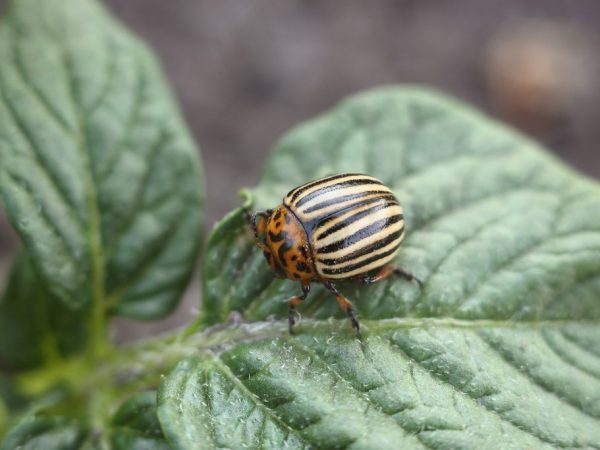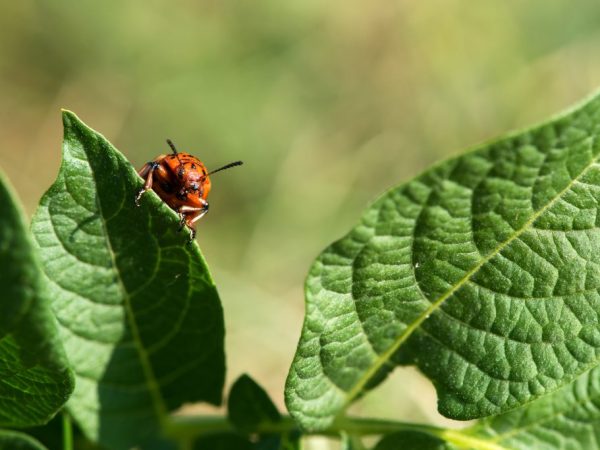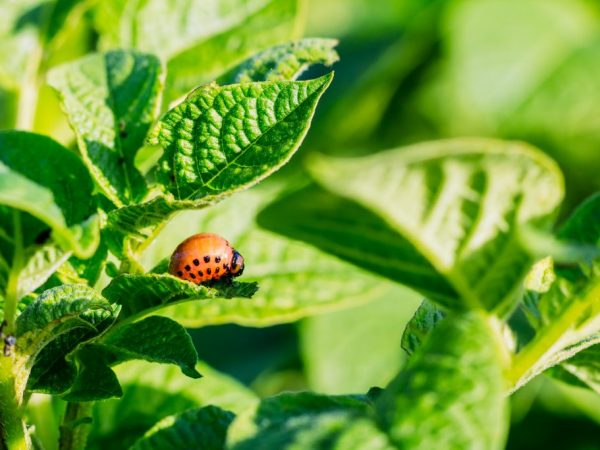Ways to combat the Colorado potato beetle on potatoes folk remedies
The Colorado potato beetle first appeared in Europe in 1877 and began to regularly cause catastrophic damage to the potato crop. In the fight against the Colorado potato beetle, you need to act decisively and consistently. Today, the fight against the Colorado potato beetle on potatoes with folk remedies is the most popular alternative to chemical treatment. Folk remedies for the treatment of the Colorado potato beetle are popular because, if the measures are followed, they do not harm the plantings and do not adversely affect the potato tubers. For treatment with folk remedies to be successful, you need to fight the Colorado potato beetle in the early stages of its appearance.

Fighting the Colorado potato beetle folk remedies
Characteristics of the Colorado potato beetle
In order for vegetable growers to diagnose pest infestation correctly, the Colorado potato beetle must be identified that it is he. The insect can be up to 15 mm long and has unique identifying features. On the body of an adult pest, there are 5 black longitudinal stripes and yellow wings. You can also see several black spots on the yellowish or orange abdomen.
In the soil, you can see the larvae of the pest, which appear with a reddish-brown body, there are bright, black spots on the head and on the sides of the pest.
Males and females are visually almost indistinguishable. Colorado potato beetle eggs can mature from 3 to 15 days depending on weather conditions. Over the next 2-4 weeks, the larvae develop in various stages. The larvae then fall to the ground to penetrate deeply into the soil. After about 1 month, the pests crawl like adult beetles and their life cycle repeats.
Reasons for the appearance
- In colder climates, adults hibernate deep in the soil. In this case, it is very important to carry out soil processing before planting the potatoes.
- When the temperature is 15 degrees and above, the beetles go hunting and start hitting the planting. In this case, insects must be removed from plantings until the moment of warming.
- Nests are located in groups on the lowest leaves of the plant, so it is important to weed the beds and spud the potatoes on time.
Why fight
It is recommended to fight the appearance of the Colorado potato beetle immediately and you can use available methods for this. If an insect infestation is triggered, the beetle can eat all the potatoes. The Colorado pest reproduces quite actively, so many gardeners do not use chemicals. The main reason for this is the beetle's ability to flexibly and quickly adapt to any chemical-based drug.
This is accompanied by the rapid development of insecticide resistance. Experienced gardeners are trying out all sorts of options and methods in the fight against the striped beetle. It is not easy to destroy it due to its biological specificity, but it is possible. Popular recipes from decoctions and infusions of various plants have proven themselves well.
Please note that summer heat and excess moisture are detrimental to insects. For this reason, they hide in the soil several times per season, so some methods of fighting the parasite may be ineffective.
Methods of dealing with the Colorado potato beetle
You can eliminate striped beetles on potatoes with various folk remedies that have been tested by gardeners for many years. Basically, gardeners cultivate the soil before planting and use different methods of influencing the beetle in order to surely eradicate the pest from their site. In the fall, the soil where the potato tubers will be planted must be dug deep. In deep furrows for potatoes, you can try to throw fresh manure and loosen the soil between it and the plantings. During the winter, manure will burn out most of the parasites and larvae, and in the spring when the snow melts from the soil, the manure will become an excellent fertilizer.
You can make different mixtures such as manure with horseradish or nettle. You can fight the pest with the help of mint, cumin or mustard, or sprinkle the planting site with onion husks, wood ash. The pest does not tolerate all these smells. In the struggle for a bountiful harvest, you can prepare special herbal decoctions, mustard or vinegar. With the help of such decoctions, the smell of which is not tolerated by pests, Colorado beetles leave your potatoes for more convenient plantings.
Simple ways
Pest picking by hand

You can pick beetles with your hands
Many gardeners adhere to the rule that they do not use various chemicals or even harmless folk remedies for growing vegetables. Therefore, in this case, you can get rid of the insect only by manually removing it from planting. To do this, you need to wear protective gloves and inspect each potato bush. As soon as you see the Colorado potato beetle, you should move it away from your plot. Such a measure of protecting your plantings is considered more humane for nature, but this method of eliminating the pest takes a long time.
Plants that repel Colorado potato beetles
Properly planted plants will help prevent the spread of Colorado pest larvae. When planting tubers, you can throw the seeds of one of these plants into the hole:
- Beans
- Dill
- Coriander
- Calendula
- Tansy
- Basil
The Colorado potato beetle will not damage your plantings if it senses the presence of these plants in the soil. Also, together with them, you can perform mustard processing. Many gardeners consider it an effective way to plant garlic around the perimeter or between the rows of potatoes, and with it, onions. Garlic and onions have a pungent odor that the Colorado potato beetle cannot tolerate.
Hilling potatoes
Hilling helps prevent insects from entering your plantings by creating a natural barrier to pests. By hiding young shoots in a layer of soil, additional shoots form on the plant. As a result, the bush grows, becomes more powerful and resistant to insect attacks. Potatoes should be hilled several times during the period of growth of the root crop - this is May, June and July.
Early potato varieties can be hilled as soon as sprouts have appeared, later potato varieties should be hilled when the plant has reached a height of 5-10 cm. After hilling, the soil is loosened between the rows. Hilling and loosening will save your plantings from nesting eggs and beetles. After hilling young potatoes around the bush, you can pour some wood ash, and then onion husks. Ratio in proportion - half a glass of ash and a handful of husks. The smell of rotting husks is great for repelling the insect.
Colorado potato beetle traps
Gardeners often use so-called pest traps. In the spring, as soon as the soil has woken up and the night frosts have ended, you can pour heaps of potato peels at different ends of the garden. After hibernation, insects attack easy prey. The main thing here is not to miss the moment and observe when most of the pests will gather.After that, the beetles should be collected in a jar and released as far as possible from their site. According to the same method, there is another option, several potatoes are laid out in glass floor-liter jars and put across the field in small depressions. When the cans are full of pests, they need to be released elsewhere.
Using solutions
Copper sulfate
Before planting potatoes, you can treat the tubers themselves from parasites and fungal diseases. A teaspoon of copper sulfate is diluted in a three-liter jar, the tubers that are being prepared for planting are dipped into the solution for 1-2 minutes. Then the tubers are dried and planted in the ground three days later. Instead of copper sulfate, you can use potassium permanganate. This is done this way, one gram of potassium permanganate is diluted with a liter of water and mixed thoroughly. It is recommended to fill the sprouted tubers with this solution for half an hour, and then remove, dry and plant on the third day.
Vinegar treatment

You can get rid of pests
A vinegar rinse gives a good effect in protecting the plant. Add half a liter of vinegar and 100 grams of baking soda to a 10 liter bucket of water. After preparing the mixture, you can immediately spray the bushes. When carrying out work on spraying with any solution, it is recommended to strictly observe safety precautions.
Wood ash
Before planting, the field can be sprayed with the following composition: 1 kg of wood ash per 10 liters of water. It is advisable to pollinate 2-3 times before the emergence of potatoes. When planting a root crop, a small amount of fertilizer and wood ash is added to each hole. In the ash mixed with fertilizers, you need to plant potatoes in the usual way and sprinkle with soil on top. Ash is also used in this version: hot ash is poured into a hole to a depth of 10-15 cm and covered with soil on top. After 2 weeks, you can plant the potatoes in the prepared soil.
Spraying grown tops of up to 15 cm can be carried out using a soapy solution with ash. Pour water into a 10 liter saucepan or bucket, pour 1 kg of ash and boil for 5 minutes. The solution should be infused for 50 hours. Next, the solution must be filtered and rubbed into it half of a piece of laundry soap, mix everything thoroughly and dilute with another 10 liters of water.
With the help of infusions
Infusion on tobacco
To prepare a tobacco infusion, you need to boil 10 liters of water, pour 500 grams of tobacco into the water, mix everything and let it brew for 20-30 hours. After the infusion is infused, add half of the laundry soap to it, mix and add another 10 liters of water. We spray the young tops with the resulting infusion. The pest does not like the smell of tobacco and the beetles go to other areas.
Wormwood and dandelion infusion
An infusion of wormwood with wood ash is a good deterrent to the beetle and its larvae. To prepare the infusion, you should boil 5 liters of water, add 150 grams of bitter wormwood and a glass of wood ash to the water. Insist for 3 hours and spray on the tops. The pungent smell of wormwood discourages the pest from hunting for the entire growth of potato tubers.
One of the first flowers to appear in the spring is the yellow-headed dandelion and it can be beneficial in the struggle for potato yield. To prepare the infusion, you need to take a glass of collected dandelions, add a glass of horsetail and boil in a 10 liter saucepan for 30 minutes. Cool the resulting infusion and dilute with another 10 liters of water. Spray the potato tops with dandelion infusion during the growth period.
Horseradish infusion
Basically, such an infusion in the fight against the Colorado potato beetle is popular in the countries of the former USSR. To prepare a horseradish infusion, you need to take fresh or dried horseradish. If freshly cut horseradish, then 1 kg is required, if dried, then 200 grams. Horseradish is thrown into a tank or into a 10 liter barrel. The horseradish container is placed in a sunny place for 2-3 days. The resulting mixture should be filtered through a sieve or cheesecloth. Treatment with horseradish infusion is carried out both on young tops and on infected plants.The procedure for processing horseradish infusion is recommended to be repeated after 2 weeks.
Mint infusion
Experienced gardeners spray the plantings with a mint composition almost every week from the beginning of planting potatoes to digging out the crop. For 10 liters of water, 1 kg of mint is required. The mint should be boiled for 10 minutes, then the infusion should stand for 1 hour. Before use, filter the solution and process potato planting.
Infusion of tomato tops and leaves
In the fall, you can stock up on leaves and tops from tomatoes for future use, then dry and store them in a dry and ventilated room until use. To prepare an infusion of tomato leaves for processing potatoes, you must first grind the leaves and tops, and then pour the resulting mixture with warm water. The proportions are as follows: 1 kg of leaves requires 10 liters of water. The leaves are poured with water and kept warm for 4-5 hours. You can rub half of the laundry soap into the resulting mixture. After straining, the infusion of tops and leaves of the tomato is ready for use.
Walnut infusion
Lovers of purely ecological vegetables prefer using natural methods in the fight against leaf beetles. An infusion of walnut peels and young leaves will scare away crop eaters. The skins can be cooked back in the fall when picking nuts. Add 1 kg of skins from nuts and 1 kg of young leaves to boiling water for 10 liters. The mixture must be boiled for 15 minutes, then let it brew for 30 hours and strain. Soil cultivation with walnut infusion takes place around the cultivation of root crops.


